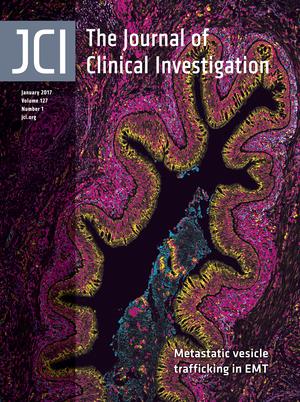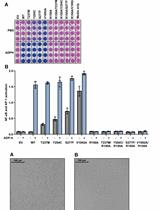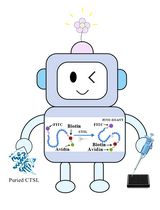- EN - English
- CN - 中文
Cell-free Fluorescent Intra-Golgi Retrograde Vesicle Trafficking Assay
无细胞荧光高尔基体内逆向囊泡转运分析
发布: 2017年11月20日第7卷第22期 DOI: 10.21769/BioProtoc.2616 浏览次数: 8716
评审: Jia LiAnonymous reviewer(s)
Abstract
Intra-Golgi retrograde vesicle transport is used to traffic and sort resident Golgi enzymes to their appropriate cisternal locations. An assay was established to investigate the molecular details of vesicle targeting in a cell-free system. Stable cell lines were generated in which the trans-Golgi enzyme galactosyltransferase (GalT) was tagged with either CFP or YFP. Given that GalT is recycled to the cisterna where it is located at steady state, GalT-containing vesicles target GalT-containing cisternal membranes. Golgi membranes were therefore isolated from GalT-CFP expressing cells, while vesicles were prepared from GalT-YFP expressing ones. Incubating CFP-labelled Golgi with YFP-labelled vesicles in the presence of cytosol and an energy regeneration mixture at 37 °C produced a significant increase in CFP-YFP co-localization upon fluorescent imaging of the mixture compared to incubation on ice. The assay was validated to require energy, proteins and physiologically important trafficking components such as Rab GTPases and the conserved oligomeric Golgi tethering complex. This assay is useful for the investigation of both physiological and pathological changes that affect the Golgi trafficking machinery, in particular, vesicle tethering.
Keywords: Golgi apparatus (高尔基体)Background
The molecular mechanisms of intracellular vesicle targeting are important to decipher to understand processes as diverse as glycosylation homeostasis, neurotransmitter release, regulation of signaling receptors and nutrient uptake (Ungar and Hughson, 2003; Fisher and Ungar, 2016). The Golgi apparatus is an excellent test case, as it maintains a network of target compartments, called cisternae, that require the specific delivery of different vesicles (Cottam and Ungar, 2012). The Golgi can also be isolated in a functional form retaining its ability for vesicle transport (Balch et al., 1984). Fluorescent labelling of vesicles and target cisternae offers a direct readout of vesicle targeting by measuring the co-localization of the two membrane fractions following a cell-free incubation. This type of measurement has some caveats. The size of vesicles is below the resolution limit of conventional microscopy, and there are only single fluorophores in the majority of the vesicles (C. Baumann and D. Ungar, University of York, unpublished data). This means that very high quality optics and sensitive detection has to be combined with automated exposure control during microscopy to avoid photobleaching, and sophisticated image processing to obtain images that are free of noise.
The assay was set up to investigate the molecular requirements of vesicle tethering at the trans-Golgi (Cottam et al., 2014). Accordingly, it was found to be dependent on functional Rab GTPases (Rabs), as the protein Rab-GDI, which extracts Rabs from membranes (Soldati et al., 1993), was found to inhibit the signal (Cottam et al., 2014). Moreover, the assay was sensitive to various defects of the conserved oligomeric Golgi (COG) tethering complex. Cytosol is an essential component of the assay mixture for obtaining activity, and when used from cells harboring patient-derived COG mutations (Wu et al., 2004; Luebbehusen et al., 2010), it inhibited the assay signal (Cottam et al., 2014). Moreover, the assay was able to differentiate the contributions to retrograde trafficking of two different COG mutants (Cog1- and Cog2-null mutations, Cottam et al., 2014), which have essentially identical cellular phenotypes in CHO cells (Kingsley et al., 1986).
Materials and Reagents
- Microscope slides and coverslips (purchased from Thermo Fisher Scientific, Thermo ScientificTM, catalog numbers: MNJ-400-030Y and MNJ-100-030J )
Note: The quality of the slides and coverslips is critical, the mentioned product does work, if others are to be used it is advised to test these. - Silica beads (5 micron silica beads) (Bangs Laboratories, catalog number: SS06N )
- 0.5 ml and 1.5 ml microfuge tubes, 0.2 ml PCR tubes
- T175 flasks (each 175 cm2) (Corning BV Life Sciences, Amsterdam, the Netherlands)
- 10 ml serological pipette
- PD-10 desalting column (GE Healthcare, Buckinghamshire, UK)
- Wild type HEK293 cells
- HEK293 cells stably expressing CFP/YFP-GalT
- Water
Note: Molecular biology grade water was used for all procedures, including the washing of microscope slides and coverslips. - Detergent decon90 (Decon Laboratories Limited, Sussex, UK)
- Potassium chloride (KCl)
- Geneticin (GibcoTM)
- Dulbecco’s Modified Eagle Medium (DMEM, high glucose, pyruvate, no glutamine) (Thermo Fisher Scientific, GibcoTM, catalog number: 21969 )
- Fetal bovine serum (FBS) (Thermo Fisher Scientific, GibcoTM, catalog number: 12657029 )
- GlutaMAX-I (an L-alanyl-L-glutamine dipeptide substitute for L-glutamine) (Thermo Fisher Scientific, GibcoTM, catalog number: A12860-01 )
- Penicillin-streptomycin (10,000 U/ml; 100x) (Thermo Fisher Scientific, GibcoTM, catalog number: 15140122 )
- Ham’s F-12 Nutrient Mix (Sigma-Aldrich, catalog number: N4888 )
- Liquid nitrogen
- Tris
- Optiprep density gradient media (Axis-Shield PoC) (Cosmo Bio, catalog number: AXS-1114542 )
- α-HA antibody (monoclonal anti-HA.11) (BioLegend, catalog number: 901513 )
- Dithiothreitol (DTT)
- Golgi membranes, vesicles, cytosol (see preparation of working aliquots under Recipes)
- Sucrose (Fisher Scientific, catalog number: S/8600/60 )
- HEPES
- Creatine phosphokinase
- GTP
- ATP
- Creatine phosphate
- Potassium hydroxide (KOH)
- Magnesium acetate (Mg(OAc)2)
- Magnesium chloride (MgCl2)
- Trypsin, 2.5% (10x) (Thermo Fisher Scientific, GibcoTM, catalog number: 15090046 )
- Phosphate buffered saline (PBS) (Thermo Fisher Scientific, GibcoTM, catalog number: 10010023 )
- Buffers (see Recipes)
- Assay sucrose
- ATP/GTP mixture (10x)
- Cytosol buffer
- HM buffer
- KHM buffer
- Reaction buffer (10x)
- Trypsin-PBS buffer
- Assay sucrose
Note: All reagents and buffers should be stored in convenient sized aliquots at -80 °C. When running low on critical aliquots (membranes, cytosol, ATP/GTP mixture), prepare a new set and test it against the old ones to ensure reproducibility.
Equipment
- Microwave oven
- Water bath
- Sonicating water bath (Grant Instruments, model number: XUBA3 )
- Incubator
- 1 ml Dounce homogenizer (DWK Life Sciences, Wheaton, catalog number: 357538 )
- Centrifuge
- Ultracentrifuge
- SW41 rotor (Beckman Coulter, model: SW 41 Ti ) and 13.2 ml thinwall ultra-clearTM tubes (Beckman Coulter, catalog number: 344059 )
- Sugar refractometer (range 0-50%) (Bellingham and Stanley Ltd, UK)
- TLA 100.3 rotor (Beckman Coulter, model: TLA-100.3 ) and 3.5 ml thickwall polycarbonate tubes (Beckman Coulter, catalog number: 349622 )
- TLS-55 rotor (Beckman Coulter, model: TLS-55 ) and 2.2 ml thinwall ultra-clearTM tubes (Beckman Coulter, catalog number: 347356 )
- Standard mammalian cell culture apparatus
- Evolve 512 EMCCD (electron multiplying charged coupled device) Camera (Photometrics, model: Evolve® 512 )
- Zeiss Axiovert 200M fully motorized inverted microscope (Carl Zeiss, model: Axiovert 200M )
- X-Cite 120Q excitation light source (Excelitas Technologies, model: X-Cite 120Q )
- CFP filter (Chroma Technology, catalog number: 49001 )
- YFP filter (Chroma Technology, catalog number: 49003 )
- Objective lens (Zeiss Plan-Apochromat 63x/1.40 Oil DIC, Carl Zeiss Ltd, Cambridge, UK)
- Black card to exclude room light from samples during imaging
Software
- ZEN 2009 software (www.zeiss.com)
- PM Capture Pro software (http://www.photometrics.com)
- AutoHotkey (www.autohotkey.com) (AutoHotkey Foundation LLC)
- ImageJ (https://imagej.nih.gov/ij/)
Procedure
文章信息
版权信息
© 2017 The Authors; exclusive licensee Bio-protocol LLC.
如何引用
Cottam, N. P. and Ungar, D. (2017). Cell-free Fluorescent Intra-Golgi Retrograde Vesicle Trafficking Assay. Bio-protocol 7(22): e2616. DOI: 10.21769/BioProtoc.2616.
分类
生物化学 > 蛋白质 > 活性
细胞生物学 > 细胞器分离 > 高尔基体
您对这篇实验方法有问题吗?
在此处发布您的问题,我们将邀请本文作者来回答。同时,我们会将您的问题发布到Bio-protocol Exchange,以便寻求社区成员的帮助。
Share
Bluesky
X
Copy link













